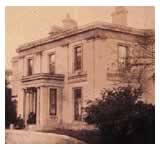|
A Century Of Mystery
![Gorse Hall [click for larger image]](sitebuildercontent/sitebuilderpictures/.pond/gorsehall.jpg.w180h286.jpg)
Almost a century after it occurred, the killing of Stalybridge mill-owner George Harry Storrs continues to maintain a
grip on the local imagination. A classic example of the unsolved murder-mystery, it has been the subject of books, articles
and television programmes. Theories abound as to who stabbed Storrs, and why they did so.
George Harry Storrs (1861-1909) was the third son of William Storrs, a successful builder and mill-owner; and a pillar
of the community in Stalybridge, where he was a councillor and magistrate. However, in contrast to his father, George Harry
was a quiet man, and played no part in public life. He did not marry until he was 31, when William bought him Gorse Hall as
a wedding present, at a cost of £3,250.
On Friday 10 September, 1909, coachman James Worrall arrived at Stalybridge police station claiming shots had been fired
at Storrs by a man who had appeared at a window. Although the ensuing investigation discovered a hole in the glass,
there was no evidence of a firearm having been discharged.
Even so, the police took the matter seriously and, as there was no telephone at Gorse Hall, and the cost of installing
one would have been excessive, it was agreed that Storrs should install a bell which could be rung in case of emergency. The
police also began to patrol the grounds of the hall. All was quiet until late on Friday, October 29th, when the sound of the
bell began to boom out across Stalybridge. Officers swiftly made their way to the hall only to be greeted by Storrs,
who told them he had decided to try out the bell to see if it would have the desired effect. At 9.15pm, the following Monday
evening (November 1st), Storrs' cook, Mary Evans, encountered an armed man at the back door of the hall. After uttering the
words "say a word and I shoot," the intruder made his way inside where he was confronted by Storrs and a struggle ensued.
As Mrs Storrs ran to the roof to ring the bell, their niece, Marion Lindley, set off into Stalybridge to get help.
The police arrived to find Storrs barely alive, the room swimming in blood from 15 stab wounds. They tried to question
him about what had happened but, although there was a feeling that Storrs knew who his attacker was, he said nothing of importance
and died just after 10 o'clock.
Soon after, Cornelius Howard stood trial, but was acquitted. The following year, Mark Wilde, from Robinson Street,
was also tried. However, although the feeling in Stalybridge was that Wilde was the murderer, he was also found not guilty.
|
 |
|

|
| Gorse Hall |
related internet links
the local newspaper.
the website includes a
great local history section
|
 |
|
|
 |
|
|
|

